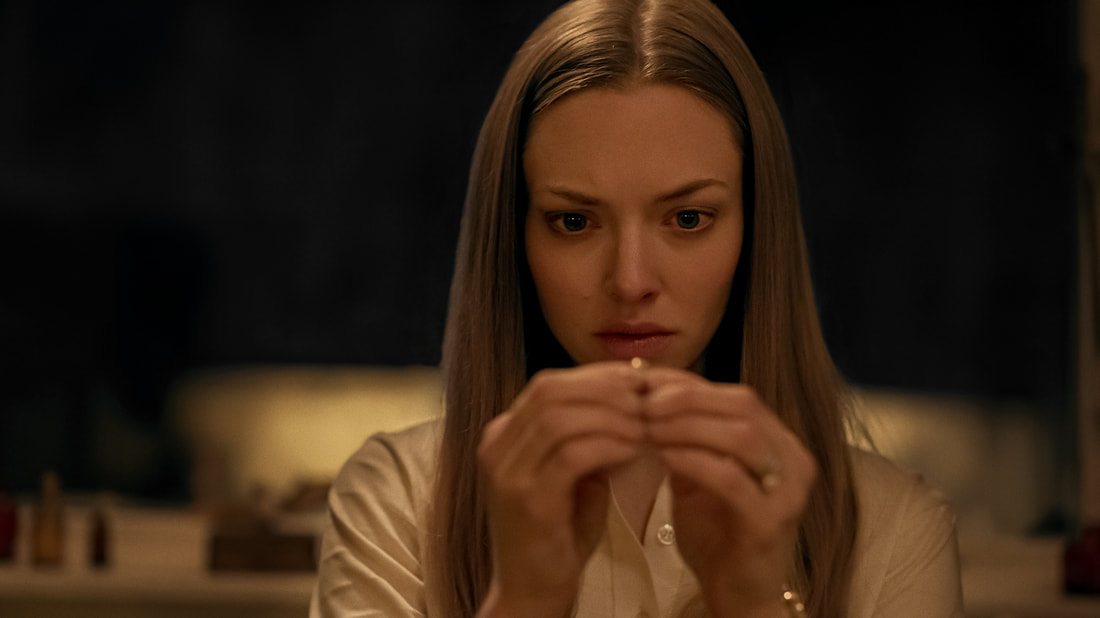|
Amanda Seyfried in Things Heard & Seen (2021) Somewhere deep within Things Heard & Seen is the potential for a decent horror film. The ingredients are on the page. Based on the acclaimed gothic novel ‘All Things Cease To Appear’ by Elizabeth Brundage, the scares are rooted in sacrifice and isolation, both of which can describe the protagonists’ marriage. The Claires are a Manhattan couple who move from the city to a historic hamlet in the Hudson Valley. Catherine (Amanda Seyfried) is an artist who gives up her whole life so that George (James Norton) can take an art history professor job at a private college upstate. Together with daughter Franny (Ana Sophia Heger), they move into a secluded farmhouse that spells trouble, as the opening scene suggests. This haunted house of horrors turns out to be the mirror image of the Claires’ relationship and subsequently, the film itself: doomed from the start.
The opening scene is one of many head-scratching examples of flat imagery in the film. Moments that aim for visual subtext come across as contrived. The story often falls down a rabbit hole of on-the-nose effects, including a non-threatening recurring ghost and a blackbird that crashes into a window at the most opportune moment. One scare tactic that the film does infuse well is when a spooky figure appears in plain sight and goes unnoticed. Another well-made scene captures a chilling nightmare, which causes genuine second-hand concern for the person who experiences it. But these are two of very few gems in a film that skirts past interesting themes in favour of tracing George’s increasingly unhinged motivations. Norton plays possessive arrogance scarily well, so much so that a lot of his actions warrant sighing at the screen out of frustration. His character is awful in every sense of the word; he’s a controlling husband who plays into a facade of concern for Catherine’s wellbeing. Much of the film is set up to follow how much worse he becomes. But the decision to plant these malevolent seeds for a rushed, nonsensical climax (and an even worse ending) is made at the expense of intriguing ideas that are much more worthy of exploration. The spooky things heard and seen are largely from Catherine’s perspective. Not long into the film, she begins to notice strange happenings in the house. A creaking chair, a phantom piano, a flash of light, a worsening smell, a mysterious ring, all concocted by a supernatural presence. But this presence is not lurking in solitude. George knows more about this house than he lets on, which leads Catherine to discover that their marriage is tainted by a sinister darkness. Amanda Seyfried brings a grounded, charismatic star quality to Catherine and elevates the material with a good performance that could have been great. This messy adaptation, written and directed by Shari Springer Berman and Robert Pulcini, makes it very tempting to skip what’s happening on screen and watch First Reformed (a far spookier Seyfried film) instead. The filmmakers tease an interesting narrative but switch gears to focus on George, especially in the second act when he vehemently charges at loose ends who could compromise the skeletons in his closet. As a consequence, there’s a missed opportunity in relegating Catherine to the background as she plays in reaction to him. Catherine’s disillusionment is the real underbelly of this story. She uproots her entire life (family, friends, career) in service to George’s deliberations and false promises. To watch her become so crashingly aware of what’s real, and try to catch her breath in such wild circumstances, leaves a lasting impact that Seyfried puts a compelling stamp on. The film takes a disappointing turn by veering further away from Catherine as a driving force of the narrative. The only way to kill temptation is to step right into it, according to a handyman (Alex Neustaedter) with whom Catherine finds brief…companionship. Religious language and imagery jumps out in this film, not necessary to any avail other than to recognize that these observations have been made. Catherine is a self-described conflicted Catholic girl at heart. She puts all her faith in George that everything will work out. One of the earliest scenes of Catherine shows her painting the inside of a church. It is her who conveniently finds a bible tucked away on top of a shelf in her new house. The first few questions from her mother after the big move are whether she’s been eating and praying, and if there’s a church nearby she can go to. Everyone in Catherine’s life tends to blame everything that goes wrong on her not eating. Her bulimia is depicted a few times, without being addressed. It’s one of many examples of the fast-forwarding that goes on in this film, speeding past details about characters that go unconsidered. Things Heard & Seen has a talented cast, but most are relegated to cardboard cutout characters. To name a few, Rhea Seehorn, Natalia Dyer, and F. Murray Abraham are around simply to move the plot along. There’s a gravitational pull about Seehorn’s character Justine, one of George’s colleagues. Catherine feels drawn to how free Justine is with her self and her body. Their kinship comes into play on a spiritual level later on, but as is often the case in this film, many potentially intriguing aspects are poorly executed. At one point, Abraham’s character Floyd DeBeers walks into Catherine’s house and within seconds, recognizes a spirit is amongst them and immediately wants to hold a seance without George’s presence. This is not to say that Mr. DeBeers (a fellow college professor) wouldn’t have suspicions about his colleague, nor would knowledge of the supernatural be implausible. But his character is so specifically created for such a moment to exist, as are the majority of characters in a film racing to reach a climax that needs conveniently placed roles to keep the house fires burning. Haunted houses as parallels to the people who inhabit them is a refreshing perspective to explore. Films of the past year such as Natalie Erika James’ Relic and Sean Durkin’s The Nest see the house as another character in the story, in which a labyrinth of walls and enormous empty spaces speak volumes. Not only in terms of strong imagery, but also as a powerful mirror to the psyche of a character. The fixer-upper farmhouse in Things Heard & Seen plays to the idea of a new family overriding the previous owners and rearranging history, only to find that the past bleeds into the present. It is telling that the people who live in this upstate town feel compelled to the house physically and even mentally, whether it’s handymen watching it from afar or local community employees raising an eyebrow at the very mention of it. Clearly, a house whose inhabitants are doomed from the moment they step foot inside. The overwhelming isolation that this house brings particularly to Catherine also paints a clearer image of the person she’s married to. But for all the afterthoughts of potential themes that could’ve been explored in theory, the things heard and seen in the film itself are more akin to watching paint dry.
0 Comments
Leave a Reply. |
Archives
June 2024
Categories |


 RSS Feed
RSS Feed